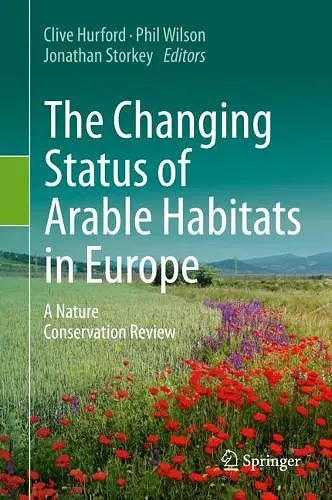The Changing Status of Arable Habitats in Europe
A Nature Conservation Review
Phil Wilson editor Clive Hurford editor Jonathan Storkey editor
Format:Hardback
Publisher:Springer Nature Switzerland AG
Published:30th Jan '21
Should be back in stock very soon

This edited volume documents the current nature conservation status of arable habitats in Europe. Arable farming systems have evolved in the European landscape over more than ten thousand years and now occupy nearly 30% of the European land area. They support species that have life cycles closely synchronised with traditional cereal growing, many of which have experienced massive declines throughout Europe. For example, in Britain, of the 100 plant species exhibiting the greatest declines in the latter half of the 20th century, 47 were typical of arable land. Despite this the habitat and many of the species associated with it remains unprotected across much of Europe.
The 22 chapters cover a range of topics, including:
- · Regional accounts describing the impact of changing agricultural practices on the arable flora;
- · The results of research and surveillance projects on the soil organisms, bryophyte flora, invertebrate fauna and pollinators of arable habitats;
- · The potential for designing multifunctional and resilient agricultural landscapes;
- The use of ex situ conservation to aid the reintroduction of rare arable plants;
- · Case studies illustrating how changing agricultural practices have impacted on bird populations in Europe;
- · The roles of remote sensing in monitoring agricultural systems;
- · How agri-environment schemes can help restore the biodiversity in arable habitats; and
- · A look forward at ways to help ensure the future security of the species associated with arable habitats.
It is clear that the biodiversity of arable land throughout Europe has undergone major changes, particularly during the second half of the 20th century, and that these changes are continuing into the 21st century. We need to develop a deeper appreciation of farmland wildlife and its integration into farming systems to ensure its future security in a world where value is increasingly expressed in terms of material profit.
This book is particularly relevant to practitioners, policy-makers and managers working in the fields of nature conservation, agri-environment schemes and land management, and to researchers working in the fields of conservation biology, terrestrial ecology, nature conservation, applied ecology, biodiversity, agriculture, agricultural ethics and environmental studies.
ISBN: 9783030598747
Dimensions: unknown
Weight: unknown
364 pages
2020 ed.